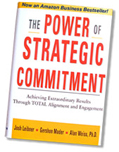
When we ask people about the strategic planning process the typical responses we get are: it’s boring. It’s tedious. Sometimes it’s torturous. The word dread crops up a lot.
It’s not too hard to figure out why.
Strategic planning can be thought of as a look backwards, plus some arithmetic. What have we done in the last three years? What incremental investment are we going to make in training or in resources or capital equipment this year? How’s that going to affect our numbers? We’re essentially going to identify the trend of the last 3 years and then add 3%.
That predetermined orientation translates to a completely uninspiring mood.
I recently heard Jack Welch talking about this. He was railing against the standard strategic planning processes because the whole orientation is broken. I want four, you want to give me two, and the game for the next six months is I’m going to twist your arm until we get to three. So we spend the next two quarters with me trying to get you to a three rather than using our energy to beat the competition.
The orientation needs to be more engaging and energizing. Yes, you need to start with an honest conversation about where you are today. What has the history been? What is the competition doing? What are we capable of? Where are we strong? Where are we weak? Fairly standard questions.
Then you take it up a notch: if we had what we needed, what could we really do? If we had the resources we needed, if we had the equipment we needed, if we had the investment we needed. It can be really effective to take off the shackles off and move away from, we’re only going to get what we had last year.
It doesn’t need to be a crazy brainstorming exercise but a simply an exploration grounded in vision. What would it take to win? What would it take to grow? How do we grow faster than anybody else is growing?
From that you create commitments. Last year we did 100. This year given the environment and what the competition is doing probably 120 is out of the question. 110 is probably more realistic. Let’s monitor it on a regular basis. If we’re beating that trend then we’ll up it a little bit. Let’s keep this a living document but we’ll also be honest against the background of what’s happening with the industry and our competitors.
We want to look at it not as an exhaustive financial planning exercise, but as an opportunity for us to identify what things could be. If we make a little more investment here of money, energy, time, people, headcount, what would that look like? What are the possibilities?
That’s not dreadful, that’s exciting.
Next up: Lip service vs. ownership. How do you know?


I’m printing this article out and leaving it in the around the office, where I hope this one guy who always makes strategic planning a nightmare stumbles across it, thanks, great article.
I certainly like the way you make it sound, it does some exciting and promising, but I know once it comes down to it, reality won’t play out like this.
Sure you make it sound all exciting, until you’re locked in a room pouring over balance sheets until your eyes cross, and it eventually comes down to we don’t have the money, cuts need to be made.
See you hit the nail on the head, planning sessions always turn into this death sport where co-workers get pitted against each other instead of focusing on the competition.
I for one have always liked strategic planning, it’s there that you can actually fight for the investment you believe the company needs in areas that could really improve your day to day, as well as the long term outlook.
I think more people should approach the issue like this, as in these economic times, you really need to squeeze the potential out of every dollar. The better your company does, the bette you do, so spending some time to make honest assessments of where you’ve been, where you are and where you possibly could go should be something everyone can appreciate.
Wow, this is one of the best pieces I’ve read in a while, if only everyone approached it like this, as reasonable people looking to maximize potential.